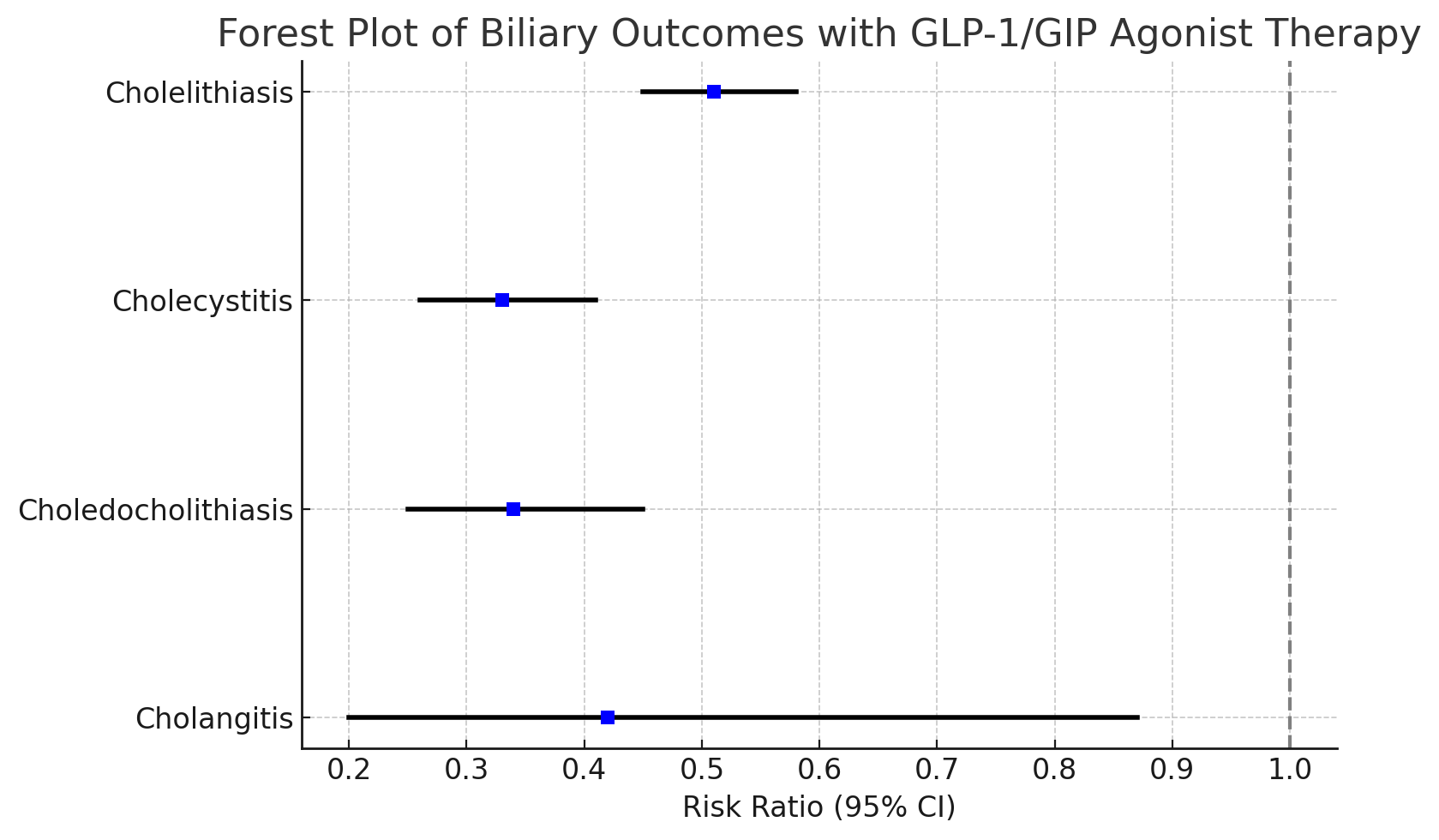Sunday Poster Session
Category: Biliary/Pancreas
P0041 - Guts, Glucose, and Gallbladders: The Protective Role of GLP-1/GIP Receptor Agonists Against Biliary Complications in Patients With Type 2 Diabetes and Inflammatory Bowel Disease
Sunday, October 26, 2025
3:30 PM - 7:00 PM PDT
Location: Exhibit Hall

Muhammad Ali Ibrahim Kazi, MD
Anne Arundel Medical Center
Annapolis, MD
Presenting Author(s)
Muhammad Ali Ibrahim Kazi, MD1, Akshay Sharma, MD1, Nirav Agrawal, MD1, Imran Qureshi, MD2, Patel Manthanbhai, MD3, Sanmeet Singh, MD1
1Anne Arundel Medical Center, Annapolis, MD; 2Rutgers New Jersey Medical School, Newark, NJ; 3University of Toledo College of Medicine and Life Sciences, Toledo, OH
Introduction: Type 2 diabetes mellitus (T2DM) and inflammatory bowel disease (IBD) frequently coexist, presenting unique challenges in clinical management due to overlapping inflammatory and metabolic pathways. GLP-1 receptor agonists and dual GLP-1/GIP agonists are increasingly utilized for glycemic control and weight management in T2DM. While their effects on gastrointestinal outcomes have been broadly studied, limited data exist on their impact on biliary complications in patients with coexisting IBD. This study aims to address this gap by evaluating biliary outcomes in patients with T2DM and IBD who were treated with GLP-1/GIP agonists compared to those who were not.
Methods: This retrospective cohort study utilized the TriNetX global health research network. Adults (≥18 years) with both T2DM and IBD (Crohn’s disease or ulcerative colitis) were grouped into two cohorts: those prescribed GLP-1/GIP receptor agonists (semaglutide or tirzepatide) and those not. The index date was the first date meeting inclusion criteria; outcomes were assessed from one day post-index.
Propensity score matching (1:1) was performed using variables including:
Results: Patients treated with GLP-1/GIP receptor agonists demonstrated significantly lower risks for several biliary complications:
Discussion: GLP-1 and dual GLP-1/GIP receptor agonist therapy in patients with T2DM and IBD is associated with significantly lower risks of biliary complications. These findings highlight a potential protective effect and support broader use of these agents in patients at elevated risk for biliary disease.

Figure: Forest Plot of Biliary Outcomes in Patients with T2DM and IBD Treated with GLP-1/GIP Receptor Agonists
Disclosures:
Muhammad Ali Ibrahim Kazi indicated no relevant financial relationships.
Akshay Sharma indicated no relevant financial relationships.
Nirav Agrawal indicated no relevant financial relationships.
Imran Qureshi indicated no relevant financial relationships.
Patel Manthanbhai indicated no relevant financial relationships.
Sanmeet Singh indicated no relevant financial relationships.
Muhammad Ali Ibrahim Kazi, MD1, Akshay Sharma, MD1, Nirav Agrawal, MD1, Imran Qureshi, MD2, Patel Manthanbhai, MD3, Sanmeet Singh, MD1. P0041 - Guts, Glucose, and Gallbladders: The Protective Role of GLP-1/GIP Receptor Agonists Against Biliary Complications in Patients With Type 2 Diabetes and Inflammatory Bowel Disease, ACG 2025 Annual Scientific Meeting Abstracts. Phoenix, AZ: American College of Gastroenterology.
1Anne Arundel Medical Center, Annapolis, MD; 2Rutgers New Jersey Medical School, Newark, NJ; 3University of Toledo College of Medicine and Life Sciences, Toledo, OH
Introduction: Type 2 diabetes mellitus (T2DM) and inflammatory bowel disease (IBD) frequently coexist, presenting unique challenges in clinical management due to overlapping inflammatory and metabolic pathways. GLP-1 receptor agonists and dual GLP-1/GIP agonists are increasingly utilized for glycemic control and weight management in T2DM. While their effects on gastrointestinal outcomes have been broadly studied, limited data exist on their impact on biliary complications in patients with coexisting IBD. This study aims to address this gap by evaluating biliary outcomes in patients with T2DM and IBD who were treated with GLP-1/GIP agonists compared to those who were not.
Methods: This retrospective cohort study utilized the TriNetX global health research network. Adults (≥18 years) with both T2DM and IBD (Crohn’s disease or ulcerative colitis) were grouped into two cohorts: those prescribed GLP-1/GIP receptor agonists (semaglutide or tirzepatide) and those not. The index date was the first date meeting inclusion criteria; outcomes were assessed from one day post-index.
Propensity score matching (1:1) was performed using variables including:
Demographics: age, sex, race, ethnicity
Comorbidities: cardiovascular, renal, pulmonary, hepatic, oncologic, infectious, autoimmune, and GI-related conditions
Procedures: GI surgeries
Medications: insulin, oral antidiabetics, and SGLT2/DPP-4 inhibitors
Results: Patients treated with GLP-1/GIP receptor agonists demonstrated significantly lower risks for several biliary complications:
Cholelithiasis: RR 0.51 (95% CI: 0.45–0.58), p < 0.001
Cholecystitis: RR 0.33 (95% CI: 0.26–0.41), p < 0.001
Choledocholithiasis: RR 0.34 (95% CI: 0.25–0.45), p < 0.001
Cholangitis: RR 0.42 (95% CI: 0.20–0.87), p = 0.016
Perforation, Sphincter Spasm, and Biliary Cyst: All showed lower or zero incidence in the treatment group (p ≤ 0.002)
Discussion: GLP-1 and dual GLP-1/GIP receptor agonist therapy in patients with T2DM and IBD is associated with significantly lower risks of biliary complications. These findings highlight a potential protective effect and support broader use of these agents in patients at elevated risk for biliary disease.

Figure: Forest Plot of Biliary Outcomes in Patients with T2DM and IBD Treated with GLP-1/GIP Receptor Agonists
Disclosures:
Muhammad Ali Ibrahim Kazi indicated no relevant financial relationships.
Akshay Sharma indicated no relevant financial relationships.
Nirav Agrawal indicated no relevant financial relationships.
Imran Qureshi indicated no relevant financial relationships.
Patel Manthanbhai indicated no relevant financial relationships.
Sanmeet Singh indicated no relevant financial relationships.
Muhammad Ali Ibrahim Kazi, MD1, Akshay Sharma, MD1, Nirav Agrawal, MD1, Imran Qureshi, MD2, Patel Manthanbhai, MD3, Sanmeet Singh, MD1. P0041 - Guts, Glucose, and Gallbladders: The Protective Role of GLP-1/GIP Receptor Agonists Against Biliary Complications in Patients With Type 2 Diabetes and Inflammatory Bowel Disease, ACG 2025 Annual Scientific Meeting Abstracts. Phoenix, AZ: American College of Gastroenterology.
